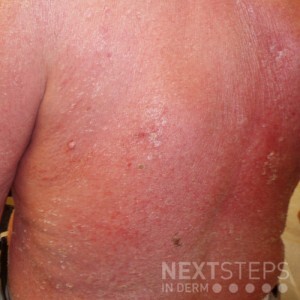
The correct answer is A. Behcet disease.
The image shows an erythrodermic patient with generalized desquamation of the skin. Many conditions may cause this, but Behcet disease is least likely.
This image is one of Sezary syndrome. Skin biopsy and blood tests are necessary for the diagnosis of Sezary syndrome. Sezary syndrome is a leukemic variant of mycosis fungoides, characterized by the triad of pruritic erythroderma, generalized lymphadenopathy, and the presence of Sezary cells (abnormally large and hyperconvoluted lymphocytes) of greater than 1,000 cells/mm3 in peripheral blood. Other manifestations include scaling and fissuring of palms and soles, alopecia, pruritus, peripheral edema, and nail dystrophy.
Exfoliative dermatitis can be manifested in many conditions other than Sezary syndrome, including pemphigus foliaceus, psoriasis, and drug reaction. “Erythroderma” is the term used to describe intense and usually widespread reddening of the skin due to inflammatory skin disease. It often precedes or is associated with exfoliation (skin peeling off in scales or layers), when it may also be known as exfoliative dermatitis. Idiopathic erythroderma is sometimes called the “red man syndrome.”
References:
Austad SS, Athalye L. Exfoliative Dermatitis (Erythroderma). In: StatPearls. Treasure Island (FL): StatPearls Publishing; May 18, 2020. Inamadar AC, Ragunatha S. The rash that becomes an erythroderma. Clin Dermatol. 2019;37(2):88-98. doi:10.1016/j.clindermatol.2018.12.002
